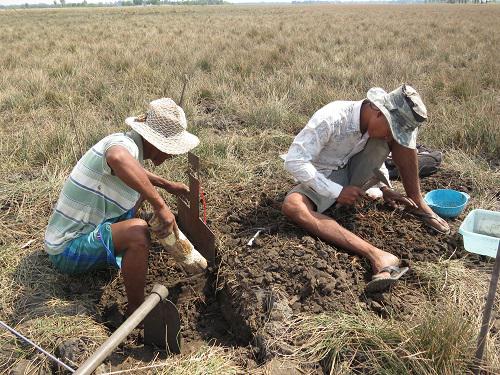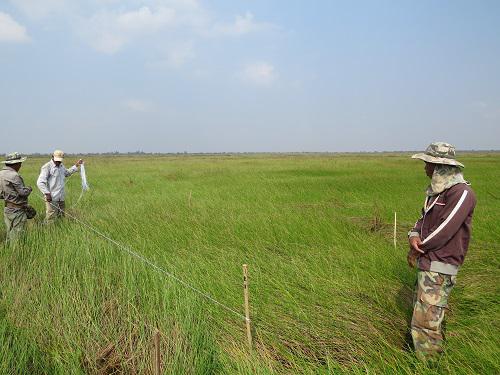Robert van Zalinge
The project will study ecological requirements of Sarus Cranes at key wetlands used in the dry season with direct participation of local community conservation groups.

Local team at AP using custom made plate to dig small pits of standard size to assess number of underground tubers.
From synchronized counts conducted across wetlands used by Sarus Cranes (Antigone antigone) in the dry season in Cambodia and neighbouring areas in Vietnam, the annual population is seen to fluctuate and there is no clear increase in numbers over time. It is clear conservation action is not having the desired effect on this species, which is considered globally vulnerable. A better understanding of Sarus Crane ecology and the spatial and temporal variation in the availability of food items important for Sarus Cranes is required. Community conservation groups have been formed to get involved in co-managing wetlands in Cambodia. However, at present an understanding of crane- and wetland ecology is still limited among stakeholders, including government and NGOs. The overall objective of this project is to provide the information necessary for managers to improve food availability for cranes in the dry season, a critical time of resource limitation, and to improve the capacity of local conservation groups through direct participation in this research project. The project sites are representative of some of the most significant areas used by Sarus Cranes in the Cambodian dry season. Results will be used to prepare recommendations for specific site management, but may also be applied to other wetlands with similar characteristics.

Local team at ATT preparing enclosed plot under guidance of Sokny.
Key to successful crane conservation in Cambodia is the human element. We will involve all stakeholders: local communities, conservation organizations, and government throughout the project duration. Two members from local community conservation groups at each wetland will be recruited as team members. They will be trained in data collection techniques and results will be discussed with them along the way so that they obtain a good understanding of Sarus Crane food selection as well as food availability and accessibility to cranes, within their wetlands. In this way they can understand the ecological requirements of cranes and will be in a better position to take up an important role in conservation work and awareness raising among their communities.